ASTR 1210 (O'Connell) Supplement
SCIENCE, TECHNOLOGY, AND SOCIETY -- AN ESSAY

INTRODUCTION
We usually use the word
"technology" to refer loosely to the raft of
electronic devices and software services that seem to be everywhere in
our lives today.
But "technology" has a much broader meaning. Anything that is useful to
humans -- that has some
practical application -- is an example of
technology. That includes all electronics, of course, but it also
includes almost every other material thing in our everyday lives, from
T-shirts to refrigerators to skyscrapers; and it also refers to the
enormous swath of practical knowledge and methodology that we make use
of to survive -- as in agriculture and medicine.
Technology ranges from the highly sophisticated to the humble.
PowerPoint slides are a familiar form of "teaching technology" --- but
so is a piece of chalk. Important technologies in earlier times were
very basic: the first human technologies to be developed were fire,
stone cutting tools and weapons, and clothing from animal skins.
Although other animals are capable of
employing
primitive tools, our human progenitors had surpassed them in
sophistication as long as 3 million years ago. The fossil record
shows that invention was slow at first, the important steps taking
tens of thousands of years. That was because hunter-gatherer
societies lived on the edge of survival and were reluctant to take
chances on diverting the labor needed to develop innovative
technologies.
Almost by definition,
civilizations are based on technology.
The earliest civilizations in Mesopotamia and Egypt (ca. 4000-3000 BC)
depended on the extensive development of technologies for building
homes and governmental/religious structures; for agriculture, water
supplies, transportation, ceramics, weaponry, methods of storing and
conveying information, and so on. Domestication of horses, cattle,
dogs, and other animals was another key technology.
Many of the simple things we take for granted today -- like cotton
thread, or glass windows, or aspirin -- are technologies that would
have been highly prized by ancient societies.
Although they may not have been determinative, the available
technologies were of great importance in shaping the behavior and
values of early human societies -- the place and character of manual
labor, for instance.

Left: The Giza Pyramids of Egypt (ca. 2500 BC); Right:
Maya Kukulcan Pyramid (Chichen Itza, Mexico; ca. 900 AD).
Useful innovations spread quickly among societies that were in close
contact with one another, but independent parallel development tended
to occur in isolated societies. The ceremonial pyramids of Egypt and
the Maya (see above) --- developed 8000 miles and over 3000 years
apart, completely independently of each other --- are examples. The
rates of development differed, and the sequences were never exact: for
instance, the wheel was not important in North or South America before
European contact in 1492. And although civilizations rise and fall,
their basic technologies tend to survive. They are taken over by
successor societies and propagate continuously into the future. As
the writer L. Sprague de Camp put it:
|
"If there is any one progressive, consistent
movement in human history, it is neither political, nor religious, nor
aesthetic. Until recent centuries it was not even scientific. It is
the growth of technology, under the guidance of the
engineers."
|
[By "engineers" here, de Camp does not mean people with formal
training in engineering, such as we have today. Rather he means
those who devoted themselves to working somewhere in the broad
spectrum of developing important technologies, including farmers,
shipbuilders, architects, metal workers, and so forth.]
Technology transcends culture and politics. The primary technologies
employed by any society are an amalgamation of innovations from
earlier times and cultures. We still use the arch -- invented by
others but first used on a large scale by the Romans (after ca. 200
BC) -- as a basic element of architectural design. We still use
Euclidean geometry (from ca. 300 BC) in uncountable daily
applications.
But why did de Camp say "not even scientific" here? Don't we think of
science as being essentially
equivalent to technology
and also as a continually "progressive movement"?
Yes, science and technology are often conflated. But they
are not identical. There are fundamental distinctions
that are important to understand, and those are the main subject of
this course supplement.
As for interruptions in the "progressive" continuity of
science: de Camp is alluding to what happened to the accomplishments
of the ancient Greeks in philosophy, science, and mathematics. In the
700 years prior to 200 AD, the Greeks had made great strides (among
their contemporaries) in understanding the physical and biological
world. They laid the foundations of the mathematics used to this day
and had even developed an
analog
computer. Their achievements in astronomy would not be superseded
for over 1300 years. But after Greek culture was absorbed by the
Roman and Byzantine Empires, this progress stalled and was even
threatened with extinction because the trove of Greek manuscripts was
scattered and almost destroyed. Enough were preserved, especially by
Islamic scholars (650-1200 AD), who elaborated on them, that they
eventually formed the intellectual basis of the scientific
Renaissance --- but this was not until ca. 1500 AD.
Science had been not only nearly static but also almost
forgotten for over a millennium, whereas technology had
progressed, if slowly (e.g. the compass, Gothic cathedrals,
windmills).
The technologies employed by civilizations before 1500 AD may have
been sophisticated in many ways, but they were not grounded on a
systematic, scientific understanding of nature. Today, 500 years
after the beginning of the "scientific revolution," things are
different. It is fair to say that
we now live in a scientific
civilization. This doesn't simply mean that many people are
scientists or that most people have some education in science.
Instead, it means that, whether we know it or not, we
depend on science for our wealth and well-being; that almost all
of our critical technologies are based on science; and that without
science, we would be living in a very different and very impoverished world.
We are benefitting today from the intellectual capital produced by
hundreds of thousands of scientists and engineers.
In this course supplement, we consider the effects of science and
technology on society and how our scientific understanding of the
operating principles of nature has affected human lives.
Relationship Between Science and Technology
Although science and technology are often intertwined they have
different goals and value systems, and we need to clarify the
distinctions between them:
Science is the attempt to build a systematic understanding of
natural phenomena based on a rigorous empirical standard of truth.
Science provides a conceptual framework for dealing with the world.
This kind of research is often called "fundamental," "unapplied,"
"basic," or "pure." Important examples of scientific accomplishment are
Newton's theory of gravity, Maxwell's discovery of electromagnetic
waves, Leeuwenhoek's discovery of microorganisms, or NASA's planetary
exploration missions.
Technology is the application of our basic knowledge to solve
practical problems (e.g. shelter, food, transport, energy, medicine,
tools, weapons, communication). Technology may use our basic scientific
understanding but doesn't necessarily in itself contribute to it.
Engineering is applied science/technology. Examples:
structural and civil engineering, aeronautics, pharmacology, or
computers and the Internet.
Technology always has a societal motivation, whether for ultimate good
or ill, but the main motivation for "basic" science is simply
curiosity and the desire to understand.
Job descriptions:
Scientist: "Be curious"
Technologist: "Be useful"
Today there is a strongly symbiotic relationship between
science and technology because new technology provides new tools that
enable better scientific understanding and vice versa. Scientists
often employ the most advanced technologies available in their
work. The Large Hadron
Collider and the
LIGO gravitational wave
detection observatory are examples of cutting-edge technology put
to use in basic scientific research. In some areas, the distinctions
are blurry. For instance, the push to develop
"high temperature superconductors" is driven by their potential
for applications in lossless electrical power transmission, but the
process of exploring the nature of new, often exotic, materials also
provides new scientific insights.
Until the scientific era, new technologies were developed
through
trial and error, building on intuition drawn from
everyday personal and societal experience. Beginning in the 17th
century, science was a
new analytical and contextual mode of
thinking about the natural world.
The
main hallmarks of science were the
rejection of supernatural explanations, a demand for repeated
verification by empirical tests, and insistence on accepting new
interpretations only if they were consistent with all the known facts.
The influence of science on technology began slowly in the 17th and
18th centuries. But the pace accelerated as science demonstrated its
value as a means to solve many problems that at first seemed
intractable: e.g. questions like "what causes bubonic plague?" or
"what are the stars?" By the mid-1800's, it was clear that science
offered a
demonstrably reliable and powerful understanding of the
natural world.
Technologists began to realize great advantages by adopting not only the
results of science (e.g. Newton's Laws of Motion,
thermodynamics, electromagnetism, chemistry, biology, geology,
hydrodynamics, the structure of matter) but also its methods
(critical thinking, skepticism, rational analysis, empirical testing,
calculus, statistics, double-blind medical trials, etc.).
Today, our scientific understanding of many aspects of the natural
world is truly
profound -- as it should be after hundreds of
years of concentrated effort. It encompasses almost everything we
encounter in everyday life. Consequently,
science now usually
precedes technology. Trial and error are certainly still
central to technology development, but the essential foundations for
experimentation come from science. Most of the important technologies
of the last 200 years have been based on earlier scientific
research.
The Critical Conceptual Path: All
technology is utterly dependent on a huge store of knowledge and
invention that extends far back in human history. For each important
technology, we can construct a "critical conceptual path" of the main
steps leading to its realization. Almost all modern technologies
depend on a long list of discoveries in
curiosity-driven basic science. Most will go all the way back
to the 17th century scientists.
Individuals like Galileo, Einstein or Pasteur can make important
breakthroughs, but progress in science inevitably depends on the
contributions of many people. For instance,
a 2015 study of the development of a new drug to fight
metastatic melanoma concluded that its critical conceptual path
extended back over 100 years and involved 7000 scientists working at
5700 different institutions. Most of this path involved basic
research disconnected from immediate commercial or clinical
applications.
The recent development
of vaccines
for the COVID-19 virus is a perfect example of how basic research
underpins essential technology. With older technology, it normally
took years to perfect viral vaccines. However, the discovery of the
structure and function of
the "messenger
RNA" molecule in 1961 began a long chain of research in cell
biology that ultimately led to the very rapid development, in only a
few months' time, of COVID-19 vaccines that use mRNA to induce human
immune system resistance to the virus.
Conversion Time: The time scale
for conversion of basic scientific discoveries into practical
technologies varies enormously. Consider some examples from
research in physics:
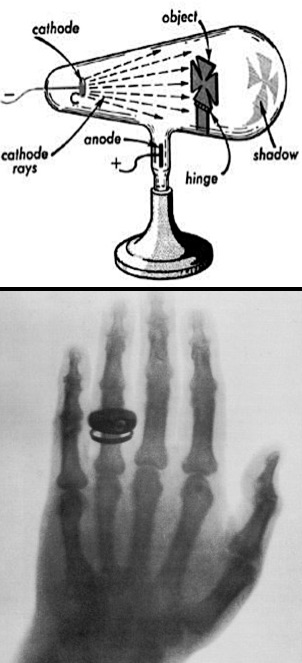 X-Rays (1895): X-Rays were accidentally discovered by
Roentgen in the course of basic research on the physics of
electromagnetic waves using cathode ray tubes like the one shown
at the right. One of his earliest
X-ray images, of his wife's hand, is also shown. Conversion time
to medical applications: 1 year. This is a good example of
a technological problem that couldn't be solved by trying to solve
it. A direct engineering approach to devising a non-invasive
mechanism to examine internal human anatomy would have failed
miserably.
Human Space Flight (1961): The basic scientific
understanding needed to build rockets and navigate through space
had been established since the 19th century, so the investment of
large amounts of government money (in both the US and USSR) was
able to solve the other formidable technical problems necessary to
enable space flight within 5 years of a political decision to go
forward. Conversion time: 280 years (from Newtonian orbit
theory, the essential conceptual foundation of space flight).
CD/DVD Players (1982): Here, the critical
conceptual path includes Einstein's work on induced transitions of
electrons in atoms (1916), which was the essential idea in
creating the
lasers that are used to convert digital disk
recordings into electronic signals. (Similar lasers are the basis
of data transmission by fiber-optic cables, now the main
technology used to drive the Internet.) Conversion time: 66
years.
X-Rays (1895): X-Rays were accidentally discovered by
Roentgen in the course of basic research on the physics of
electromagnetic waves using cathode ray tubes like the one shown
at the right. One of his earliest
X-ray images, of his wife's hand, is also shown. Conversion time
to medical applications: 1 year. This is a good example of
a technological problem that couldn't be solved by trying to solve
it. A direct engineering approach to devising a non-invasive
mechanism to examine internal human anatomy would have failed
miserably.
Human Space Flight (1961): The basic scientific
understanding needed to build rockets and navigate through space
had been established since the 19th century, so the investment of
large amounts of government money (in both the US and USSR) was
able to solve the other formidable technical problems necessary to
enable space flight within 5 years of a political decision to go
forward. Conversion time: 280 years (from Newtonian orbit
theory, the essential conceptual foundation of space flight).
CD/DVD Players (1982): Here, the critical
conceptual path includes Einstein's work on induced transitions of
electrons in atoms (1916), which was the essential idea in
creating the
lasers that are used to convert digital disk
recordings into electronic signals. (Similar lasers are the basis
of data transmission by fiber-optic cables, now the main
technology used to drive the Internet.) Conversion time: 66
years.
The length and complexity of the critical conceptual path behind the
"latest innovations" is the reason that politicians and opinion-makers
who insist on the "relevance" of scientific research,
especially by expecting near-term applications, are misguided --- and
may even inhibit progress.
The "Big Four" Benefits of Technology to Modern Society
If you asked historians of technology to list the inventions or
technological developments most important to today's society, you would
get a range of opinion on the "top-ten." But any sensible list would
include the following four categories:
Information Technology: None of the refined, modern versions
of human technology would exist without the ability to record vast
amounts of information and transmit it accurately from person to
person and generation to generation. The development of written
languages (ca. 3000 BC, in Mesopotamia) was, of course, crucial.
Through medieval times it was possible to convey knowledge on a
modest scale by laborious manual writing and copying and some
scattered experiments with printed material. However, only the
advent of mass-produced printed books based on
Gutenberg's
design of printing presses using metallic movable type
(ca. 1440) opened the doors to the information
revolution.
Within 150 years, 200 million volumes had been printed. Books
ushered in the modern age. Science depended on them. Universities
flourished because the ability to deal with large amounts of
specialized information in books became essential to society.
Beginning in the mid 19th century, information transfer
proliferated thanks to the automated rotary press and inventions
like the telephone and the linotype machine. In the last 35 years,
the Internet and other electronic technologies
have greatly accelerated the spread and creation of information.
Their societal impact has not yet matched the monumental
watershed established by the printed book, but the related
looming prospect of
artificial
general intelligence would do so.
Agricultural Genetics: "Genetic engineering," the creation of
artificial life forms, is nothing new. It has been going on for
thousands of years. You will be shocked when you click on
this picture of the most familiar artificial life form.
Essentially all the food we eat is derived from deliberate
human manipulation of plant and animal gene pools. (The main
exception is wild seafood.) Until the mid 20th century, the
techniques employed were cross-fertilization, selective breeding,
population culling, and other "natural" methods. As our
understanding of genetics matured (ca. 1900-1950), these
techniques became science-based. Eventually, we learned how to
directly manipulate cellular material (ca. 1970+). Molecular
biology now offers an ultimate genetic control technology.
Another key
invention for agriculture was the
Haber-Bosch
process (1909) for producing synthetic chemical
fertilizers --- a main contributor to the "green
revolution" of the last 75 years, without which famine would
be widespread.
Control of Infectious Disease: The control of the microorganisms
(bacteria, viruses, fungi, parasites) that cause infectious disease
is one of the most important contributions of science & technology.
In fact, many of us would not be alive today without it (because a
direct ancestor would have died too early). But as recently as 350
years ago, communicable disease was thought to be produced by evil
spirits, unwholesome vapors, "miasmas," or other mysterious agents.
No one imagined that it was caused by invisible lifeforms until
Leeuwenhoek in 1676 used the newly-invented microscope
to discover microscopic organisms.
Widespread production in the 1940's and later of agents
-- "antibiotics" --
that could attack specific types of harmful bacteria was one of
the most important advances in medical history. As we are all
aware today, in the wake of the COVID-19 pandemic, "public
health" consists mainly of systematic methods for controlling
microorganisms.
Electricity: Electricity is the primary tool of modern
civilization, yet few people appreciate this or have any idea of
how electricity was discovered or converted to useful technologies.
We explore those topics in the next section.

Electricity: A Case Study
The most obvious manifestation of electricity today is in sophisticated
electronics: smart phones, DVD players, HD TV,
personal computers, video games, and so forth. But these are
luxuries, and it should be easy to imagine being able to live
comfortably without them---in fact, people did so only 40 years
ago. We don't really need fancy consumer electronics, but we do need
electricity.
Our reliance on electricity is profound, and its
use is so deeply embedded in the fabric of civilization that we mostly
take it for granted. At least until there's a power failure.
Electricity supplies almost all of the power we depend on. The
ultimate source of that power may be fossil fuels, radioactivity, wind,
water, or solar radiation, but it is converted to a much more usable
form using electric generators. Electricity is now essential for
manufacturing, agriculture, communications, transportation, medicine,
household appliances, and almost every other aspect of modern life.
It's easy to overlook the ubiquity of electricity by thinking only in
terms of obviously "electrical" devices:
One crucial example: all the internal combustion engines used in cars,
trucks, locomotives, and planes require electrical ignition systems.
Our transportation systems are entirely dependent on electricity.
Two others: refrigeration and water distribution and purification
systems. Imagine the challenges in providing food and medication to the
world's population today in the absence of electrically powered
refrigerators. Anyone who appreciates hot showers taken indoors is an
unknowing admirer of electric pumps.
Aside from the power itself, electricity is also the basis of nearly all
of the critical control systems we use.
The most powerful control systems in use today are, of course,
computers
and microprocessors. These outperform human brains in raw
processing speed by factors of many millions and have advanced to the
point of duplicating or superseding human performance in games like
chess or in operating an automobile. They are used on a scale that
would have been inconceivable to people only 75 years ago.
Nonetheless, that generation also depended on electricity for control
systems: think of the
telephone operator plug-boards of the "one ringy-dingy" era.
If our knowledge of electricity could be somehow
magically subtracted
from the contents of a typical classroom, virtually everything would
disappear --- except a bunch of naked people.
More seriously, if knowledge of electricity were magically subtracted
from our society, our economy would collapse overnight, taking our Gross
Domestic Product back to the level of about 1900. Half the population
would probably die off within 12 months, mostly from starvation and disease.
The 2012-14 NBC-TV series
"Revolution" showed an action-oriented version of what a fictional
post-electricity world might be like (though one where everybody still
manages to have good hair).
An all-too-real threat to our electrical infrastructure is posed by
magnetic activity on the Sun, particularly "coronal mass ejections."
In July 2012 the Earth
only narrowly missed a CME from a solar superstorm that could have
devastated our electrical grid.
Development of Electric Technology
Electricity is the everyday manifestation of
electromagnetic
force between electrons and atomic nuclei, the second
kind of inter-particle force (after gravity) that physicists were able
to quantify. Here is a very brief history of our understanding of EM
force, divided between
"basic" and
"applied"
developments:
- ca. 1750-1830: Coulomb, Orsted, Ampere, (Benjamin) Franklin,
and other physicists explore the basic properties of electric and
magnetic phenomena. Orsted and Ampere show that an electric current
moving in a wire could produce a magnetic field surrounding
it. Basic.
- 1800: Volta invents the
first electrochemical
battery. Later, more practical designs allow electromagnetic
energy to be stored and transported. Both
basic and applied.
- Faraday
(1831) (experimental physicist) discovers
electromagnetic
induction. Basic.
Faraday found that a changing magnetic field
could induce an electric current. Together with the
fact that an electric current could induce a magnetic field, this
demonstrates the symmetry of electromagnetic phenomena.
Because the interaction of magnetic fields can produce a mechanical
force between objects, this is also the key to the development of
electric
generators and
motors,
which use magnetic fields to convert mechanical force to electrical
force, and vice-versa. These are two of the essential
technologies of the electric age.
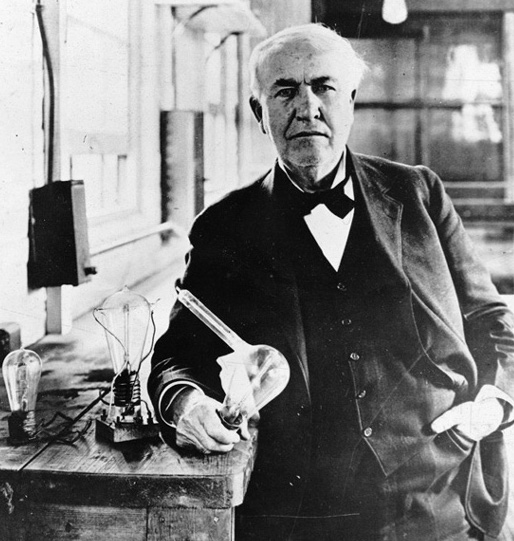
- Edison
(technologist) and others (1840--1900) develop practical electrical
generators, motors, distribution grids, and appliances. Applied.
Many people think Edison "invented" electricity. He didn't. He
invented a large number of electrical
appliances---including the electric light, tickertape
machines, the motion picture camera & projector, etc. But these
all depended on a pre-existing supply of electricity and
the knowledge of how to use it---all contributed by basic
research in physics.
- After 1850 most large-scale electrical generators relied on
steam
engines to help convert mechanical energy into electrical
energy. (Various types of wood- or coal-burning steam engines had
been developed in Great Britain in the period 1760-1800 and were
so effective at increasing economic productivity in commercial
mining and textile manufacturing that they became the basis of the
Industrial Revolution.) Today,
steam turbine engines are most commonly used in large
electric generators.
Applied.
- Readily available electrical power stimulates the invention of the
telegraph (1830's) and
telephone
(1870's), fundamentally changing human communications (and,
needless to say, behavior). Applied.
- Maxwell
(physicist): in 1865, Maxwell deduces equations giving a complete
description of the known properties of electrical and magnetic (EM)
phenomena. From these, he predicts the existence of
electromagnetic
waves that can travel through space at the speed of
light. This demonstrated that light is an electromagnetic
phenomenon, one of the most important discoveries in the
history of science. Basic.
The fact that these EM waves can have arbitrary wavelengths implies the
existence of a broad
electromagnetic
spectrum, which includes the "long-wavelength" regions we
now use for radio and television. No one had suspected the existence
of this vast spectrum, which is mostly invisible to our
eyes.
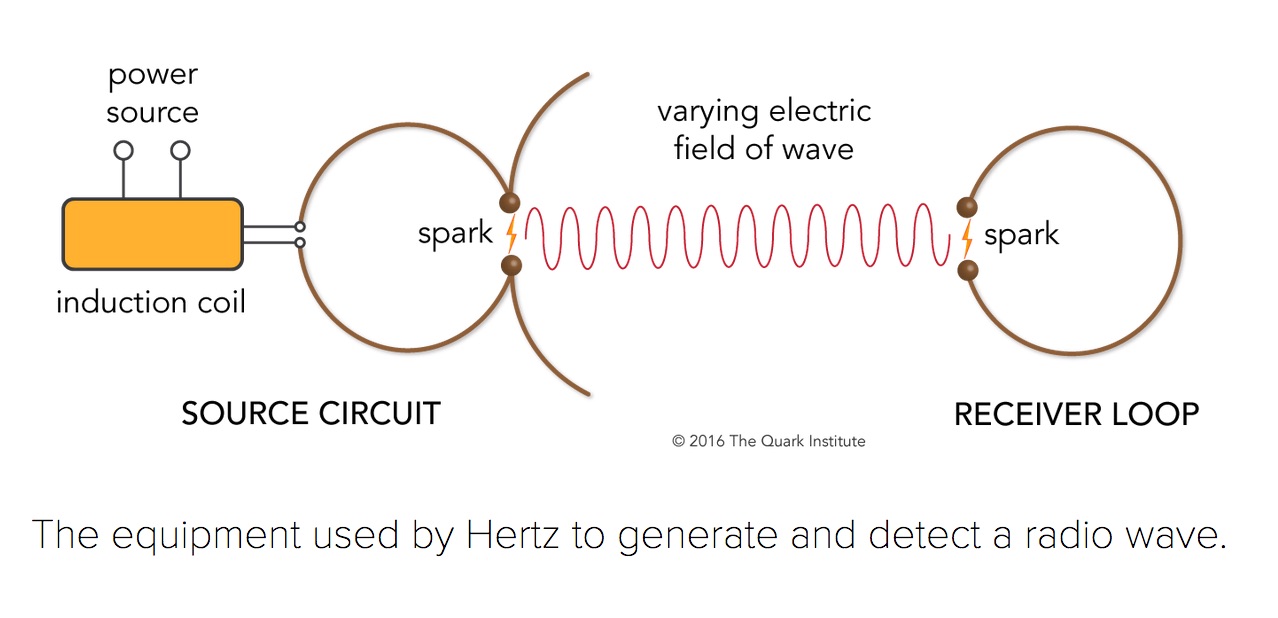
-
Hertz (physicist, technologist): accomplishes the first
generation and detection of
artificial radio waves (1887, see sketch above). After he
demonstrated the existence of radio waves, Hertz admitted that he
could not see any practical applications for them. Eight years later,
as described above, Roentgen discovers the
("short-wavelength") X-ray region of the EM spectrum, the
practical applications of which, by contrast, were immediately
apparent. Both
basic and
applied.
- Tesla, Marconi and many others develop methods for routine
transmission and reception of radio waves, even over
intercontinental distances. Just as important is the invention of
the vacuum
tube (1907), which allows modulation of EM waves so
that an intelligible signal could be impressed on them. These
developments make possible commercial
radio
(1920)
and television
(1936). All of our "wireless" technology today is
similarly based on radio
waves. Applied.
With broadcast radio and TV, cell phones, WiFi, and dozens of
other types of wireless technologies, the average US home today
is saturated with manmade EM waves.
- The development of
quantum
mechanics (basic) after
1925 leads to the miniaturization of electrical circuits using
solid-state materials like silicon and the invention
(applied) of
the transistor
(1947) and
integrated
circuits (1959), which are the central components of all
the electronics in use today. These technologies are probably
responsible for at least 50% of our Gross Domestic Product
today.
So one of the largest contributors to our economic well being was
developing an understanding of how electrons move in chunks of
silicon. Who could have predicted that? What "venture capital"
firm would have been willing to invest in that in 1920?
A Brave New World
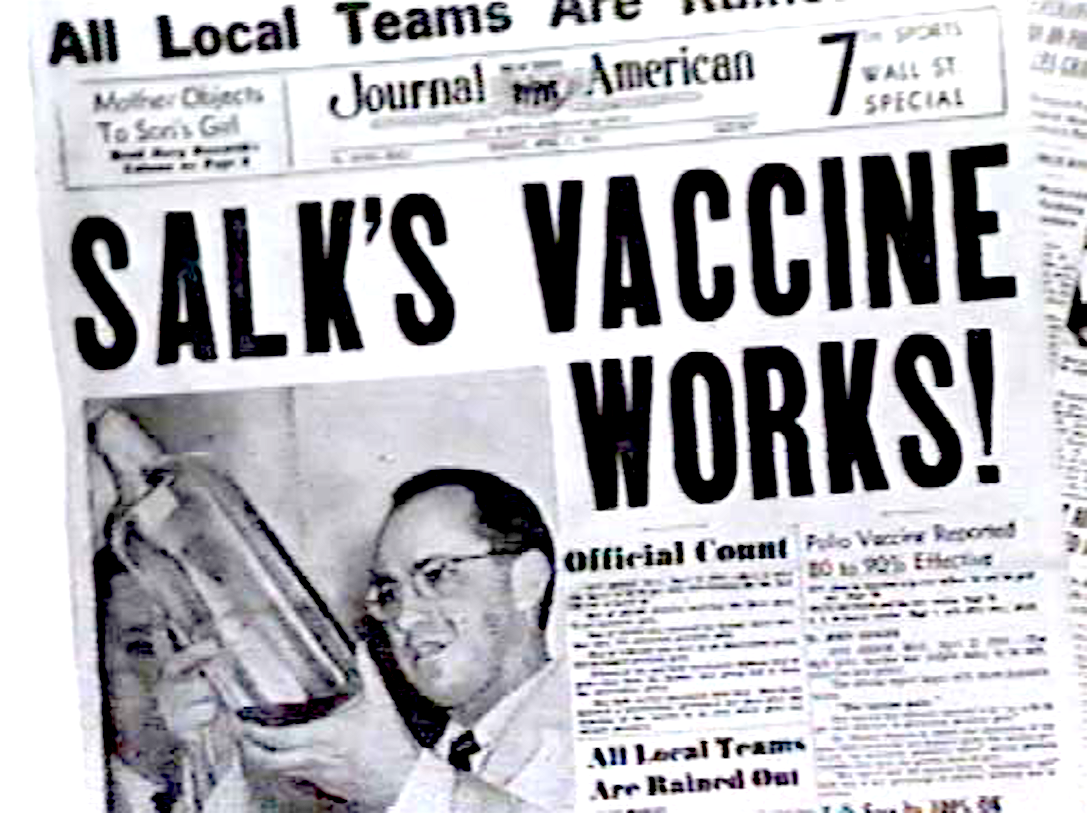
The cumulative influence of science-based technologies, including
medicine and the myriad applications of electricity and
electromagnetic waves, has been profound.
Living conditions for most human beings have been radically
transformed for the better since 1500 AD.
By every measure -- lifespan, health, quality of life, liberty,
equality, wealth, security, opportunity, and so on -- the present
circumstances for the great majority of people are an
unprecedented
improvement over the past. They are an improvement even over the
lifestyles of the most privileged individuals in earlier history ---
there aren't many sensible people who would trade indoor plumbing for
rubies and emeralds.
It's worth taking a moment to contemplate how different life was 500
years ago. You may not know who your ancestors were in the year 1500,
but you do know two things about them:
their lives were mostly not very
good and not very long. The miseries of the 16th century were
graphically depicted in
this extraordinary 1542 painting by Pieter Bruegel. His
visualization was, thankfully, exaggerated for effect. But look at
the charts linked above as you ask yourself what your own life might have
been like if you had been born in, say, 1900 -- a date only an instant
ago in the context of all human history.
As a practical example, think about this: When you get some kind of
injury or malady and you go to a doctor, you automatically assume you
will be effectively treated and usually cured. That's a new
assumption. It wasn't true throughout all of human history until about
100 years ago. In fact, one historian of medicine noted that before
about 1850, "most people were fortunate in being unable to
afford treatment" --- because medical care then was often
counterproductive,
brutal, and dangerous.
Technology alone is certainly not responsible for all the improvements
of the last 500 years, but it is central to most of the changes in our
material surroundings, and these are transpiring at an ever-increasing pace.
- Up to the late 18th century, implementation of new technologies
rarely occurred in a period shorter than a human life.
- Today, technological change is much faster and therefore more
obvious. See
this chart
showing the rate of acceptance of several new technologies. The
best recent example: smart phones, introduced less than 20
years ago, have already dramatically changed the daily lives of
billions of people.
- It is hard to visualize how rapidly modern technology has emerged
--- in only about 200 years out of the 200,000 year history of our
species.
Picture even the most far-sighted thinkers of the 18th century -- Thomas
Jefferson or Voltaire, say -- trying to figure out how a television set
works. It is utterly foreign to the familiar technologies of their era.
Its operation would appear to be "magic."
Examples like these demonstrate how important existing technologies are
in
shaping our behavior, our intuition, and our imagination -- in
fact, our entire outlook on the world around us. You cannot understand
modern culture without understanding modern technology.
Technological Excesses and Boomerangs
Technology is never an unalloyed good. Given its rapid emergence, it
is not surprising that modern technology has produced numerous
unforeseen side effects and difficulties. All technology
carries
risk. Unsurprisingly, powerful technologies are
capable of
both great benefits and great harm. The obvious
historical example of a two-edged technology is
fire. Novel
technologies will frequently
rechannel human behavior, with
consequences that are hard to predict and can be deleterious.
Technologies convey important advantages to groups or societies that
possess them, and they can be used to oppress or exploit other
groups.
As appreciative as we ought to be of the technologies that are the
foundation of our material lives today, and as impressive as are new
medical therapies or innovations in entertainment, there is a strong
thread of
discontent with technology that runs through our society.
Some of this stems simply from frustration when technologies -- usually
complex ones -- fail to work well or don't live up to inflated
expectations.
But in the last 50 years,
dangers attributed to
science and technology have often been given more prominence than their
benefits. People these days are often more suspicious than appreciative
of science and technology.
The perceived threats include environmental pollution, habitat
destruction, environmental disease, global warming, nuclear weapons,
nuclear poisoning, artificial intelligence, human cloning, and genetic
engineering, among others. Such problems have often been vividly
portrayed in literature and other media going back to
"Frankenstein"
written by Mary Shelley in 1816, such that the notion of
unthinking
scientists unleashing disasters
on the world has become a staple of popular culture in the burgeoning
genre of dystopian fiction. Some examples:
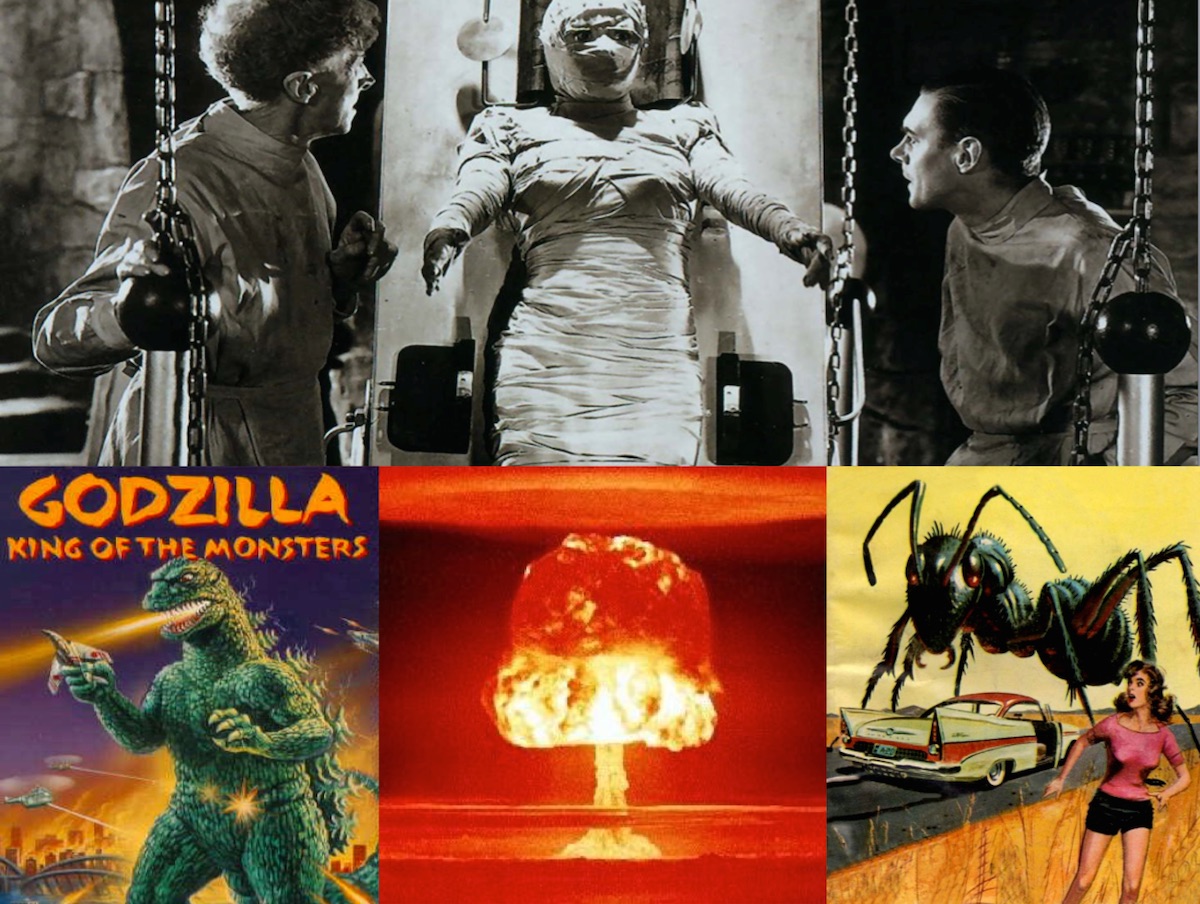
The threats are consequences not of basic science but instead of the
societal choices that are involved in developing any new technology --
which is always based on some perceived need or demand in society. The
threats are also mostly inadvertent --- i.e.
unforeseen by those who
implemented the new technologies or
grossly amplified by widespread
adoption.
"Boomerangs," paradoxes, and ironies
abound in the history of modern technology. Here are some telling
ones:
- A classic case of "irrational exuberance" over a new and initially
highly beneficial technology was the thoughtless wholesale application
of the insecticide
DDT. Early use of DDT during World War II accomplished a
miraculous suppression of the mosquitos that transmit malaria, one
of the greatest historical killers of human beings. But its use was
taken in the later 1940's and 50's to
truly absurd levels and led
to serious unanticipated environmental damage. That, in turn, was the
genesis of the book that founded the environmental protection
movement,
Silent Spring
(1962) by
Rachel
Carson, and ultimately heavy government
regulation of powerful pesticides.
- A related rapidly emerging threat: the flourishing of organisms
(bacteria, agricultural pests) that
are resistant
to the chemicals normally used to control them because
of overuse of the control agent. By eliminating their natural
enemies, overapplied agents allow resistant strains to proliferate.
An all-too-common example: people demand antibiotics to try to control
a viral infection -- but antibiotics work only against bacteria, not
viruses. Hospitals are more dangerous places today than they were 30
years ago because of the overuse of antibiotics. Industrial
agriculture also contributes to the problem by the unnecessary
introduction of antibiotics to animal feed and by massive applications
of pesticides and herbicides.
- Nuclear
weapons were, of course, always intended to be destructive,
and they were used as intended by the US to attack Japan in 1945 and
bring World War II to an end. But the long-term dangers
of radioactive fallout -- the most serious wide-area
consequence of using nuclear weapons -- were not fully understood
until well after their first use. Uncontrolled fallout effects
greatly increase the destructiveness of these weapons. In the wake of
the US attacks and subsequent controversies over weapons, fallout, and
nuclear power plants, many people came to wish that these technologies
had never been invented; some argued that our knowledge of nuclear
physics is a bad thing.
But nuclear physics also created nuclear medicine -- for
example, using radioisotopes as biochemical tracers -- without
which modern pharmacology, radiation therapy, and magnetic
resonance imaging
(MRI)
wouldn't exist. Biomedical applications of nuclear physics save
millions of lives each year. Vastly more people have benefitted from
nuclear technology than have been harmed by it (so far).
- An important unintended technological threat, one which played a
central role in recent presidential elections but which was
unrecognized by most voters, is the
widening displacement
of human labor by computers and smart machines.
Although these reduce drudgery and improve efficiency, they have also
produced major changes in employment demographics, suppressed wages,
and increased social stress. Those difficulties will only multiply
over the next decades.
- A major but often-overlooked danger to a highly technological
society like ours is its vulnerability to potential disruptions. A
pivotal feature of modern society is how complex, interdependent,
and highly specialized it is. It takes tens of thousands of
people working in coordination to produce and deliver even a single
item. No one person could build a radio, or a lawn mower, or even a
box of Cheerios from scratch. There is a highly integrated system
involving scores of specialities across a dozen different industries
behind the production and distribution of any of those things.
Without being conscious of it, we live in a huge web
of specialization and expertise. Such a system is
inevitably fragile and can be easily disrupted by incompetence
or by natural,
political, malevolent, or cultural interference. The
COVID-19 pandemic exposed some of the fragilities of
modern societies, and the increasing impacts of global
warming are exposing others.
- There may be no more timely example of a technological boomerang than
the clearly emerging negative social and political consequences of
social media Internet sites which allow unfettered human
impulse, deceit, and cruelty to blossom. The vast anonymous user base
is a font of the most irresponsible behavior imaginable. On the other
hand, it's a terrific psychological experiment in cataloging the
depths of human stupidity and depravity.
Up to about 2005, the personal computer/Internet revolution was
overwhelmingly seen as beneficial. There was a general belief that
universal access to the vast amounts of digital information available
on the Internet and to world-wide interpersonal communications could
only make the world better. It was the combination of the Internet
with smartphones and with ultimately pernicious social media software
after that time that contributed to the tumultuous political and
social state we find ourselves in today. I'm not aware that anyone in
2005 predicted the path that the revolution would take.
The digital environment today, especially in conjunction with
artificial intelligence, bears some
unpleasant similarities
to the fictional
Krell Machine, which wiped out its creators overnight
in the 1956 movie
"Forbidden Planet."
These are all examples of recognized technological problems. But the
hazards of technology and our ability to control them are often
not
objectively assessed. There are many cases
where
overreactions by the media, the government, or activist
groups needlessly alarmed the public -- for example: asbestos, Alar,
power transmission lines or WiFi, breast implants, and infant vaccinations.
Public concern in such areas was out of proportion to the actual
danger. It became counterproductive and diverted attention from more
serious problems.
Future Boomerangs? In 2025 we are
entering an era of technological transformation, similar to that
produced by physics and chemistry in the 20th century, based
on
molecular biology, hyper-scale information processing,
artificial intelligence, nanotechnology, and bio-electronics.
Few, if any, scientists, government officials, or corporate leaders
are perceptive enough to accurately forecast what this will bring only
25 years from now. As always, both benefits and risks have the
potential to be enormous.
Mitigation
How should we respond to adverse technological "feedback"? A first
impulse might be to argue that the associated technologies are so
threatening that we ought to suppress them --- but this ignores the
abundance of benefits they bestowed in the first place. The problem,
a difficult one, is to achieve a
healthy balance that preserves most
of the advantages while mitigating the serious disadvantages of
important technologies.
Societies have been wrestling with this for the last 200 years. A
fundamental obstacle to intelligent planning is the inevitable time lag
between introduction of the new technology and the appearance of its
major drawbacks --- especially if it has been widely adopted in the
meantime. Another is that amelioration often demands a change in human
behavior, not just the technology. The need to reduce our "carbon
footprint" to mitigate global warming is a contemporary example.
It's important to appreciate that many of the negative effects of
technology are only identifiable because of modern technology
itself. Without our sensitive instruments and diagnostic tools,
we would be poorly informed about the impact of environmental
pollution on water or air quality, the ozone layer, global warming,
induced diseases, and so forth. And achieving amelioration of the
negative effects will also depend on science and technology
themselves. A retreat from modern science or technology would produce
vast suffering.

Technology could, in fact, solve many of the environmental problems we
face --- assuming it is carefully designed and properly applied.
Failures to adequately address such problems are rarely caused by
serious technological barriers.
As an example, consider the fact that modern technology has made it
possible to take one of the most toxic materials known
(botulinum toxin, 1000 times more deadly gram-for-gram than
plutonium), and turn it into the cosmetic
Botox that thousands of
people happily have pumped into their faces every day.
Instead, continuing threats from technology are usually the product of
greed, incompetence, indifference, absence of foresight, or lack of
political will. That certainly applies to the central
environmental threat facing us and that we take up next.
The Biggest Threat
The root of almost all of our environmental problems is not any one
technology. Instead it is the inevitable product of all of them, and it
is something that almost everyone agrees is a good thing:
modern
technology keeps people alive. Life expectancy at birth has roughly
doubled since 1850. Without a corresponding downward adjustment in
birth rates, the increase in the human life span creates an imbalance
between birth and death rates.
The response to this imbalance is
exponential population growth, where the increase in the
population in any year is proportional to the population itself. The
population will grow
geometrically, not linearly,
without limit, as long as the net birth rate does not go to zero. Of
course, at some point exhaustion of resources will drastically
increase the death rate, and the population will stabilize or
decrease. That will stop the exponentiation, but we obviously would
prefer not to rely on that solution.
Population growth is the ultimate source of almost all of the
environmental threats we now face, including global warming.
Exponential growth is insidious. A tiny 2% excess of births over
deaths in a given year implies a
doubling time for the
population of
only 35 years. This is close to the actual
growth for the human population between 1960 and 1999. At that rate,
starting from 6 billion people in the year 2000, the total population
would be
42 billion --
7 times larger -- by the year
2100.
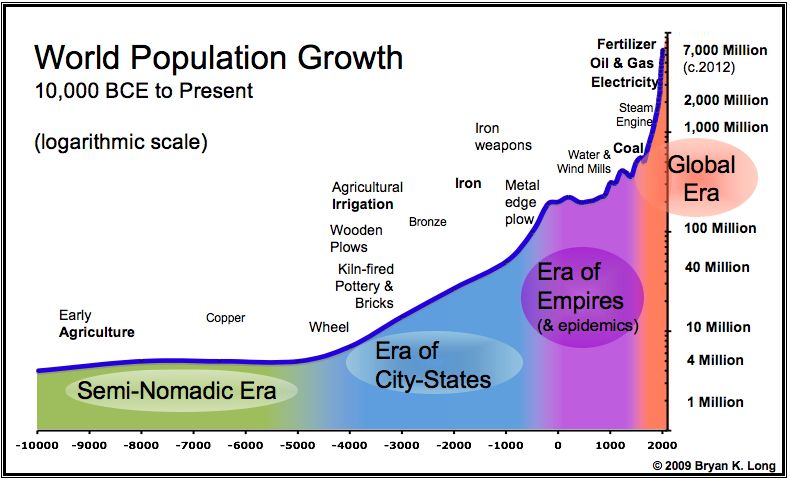
The chart above shows the growth of the human population over time and
identifies the introduction of important technologies, most of which
encouraged population expansion. Note that the vertical axis is
in logarithmic units, which exaggerates changes at small
values while reducing them at large values; click
here
for a version plotted in linear units.
The spike at the right hand side illustrates the exponential era we
are now experiencing. This graph should scare you. For a little more
context, consider that the spike shown there constitutes only 0.00001%
of the history of planet Earth. And yet the humans born in that spike
have already begun to transform its physical character.
We may not yet have reached the "carrying capacity" of the Earth, but we
are getting closer. We are probably already well in excess of the
population that is compatible with easy resource sustainability.
Fortunately, as of 2019 the net birth rate had dropped to 1%, and the
doubling time increased to 70 years. Taking into account this
important reduction, the population in the year 2100 is projected to be
"only" 11 billion -- so the situation is less dire than it might have
been. Nonetheless, demand from the growing human population has already
crossed critical local resource thresholds in many areas, as attested by
famines and other privations scattered around the world.
One of the
most striking is the
collapse of the Atlantic cod fishery, previously thought to be
inexhaustible. Another is the surge of African refugees into southern
Europe, precipitated by a decrease in arable land and mean birth
rates that are as high as 7 children per woman. And human contamination
of the Earth's atmosphere is already affecting the
climate.
There is no doubt that
unchecked population growth is the biggest
technology-driven hazard facing the human race today. Population
control is not a technologically difficult problem; effective
innovations like the birth control pill are readily available. But
there are serious ethical, not to mention political, quandaries in
attempting to control or reduce the human population. Regardless, it is
obvious that these must be intelligently confronted soon. Needless to
say,
prospects here are not good. You would be hard pressed to find
American politicians for whom population control is a serious issue, let
alone a high priority. In fact, policies on all sides of the political
spectrum, including those embedded in the current federal tax code, are
to encourage population growth.
Summary
Humans are technological creatures. The earliest urban civilizations
depended on a plethora of important technologies. Useful innovations
spread through contacts among societies and became widely adopted and
built upon. Modern science emerged from astronomy and physics in the
16th and 17th centuries and invoked a new mode of thinking about
nature by placing a premium on validating ideas by empirical tests.
Its success in making sense of the natural and human worlds
transformed the ways in which new technologies were developed and
greatly accelerated the rate of their introduction. We now live in a
scientific civilization: the main technologies we rely upon today were
made possible only by a long "critical conceptual path" of basic
scientific research which itself was mostly not motivated by practical
applications. Realizing the benefits of modern technology while
simultaneously minimizing their inevitable negative side effects is a
difficult balancing act with which all societies struggle, sometimes
without great success. The biggest technological threat facing the
world today is uncontrolled population growth, something that too few
intellectual or government leaders are addressing seriously.
If there is one main lesson from the history of human technology it is
that its trends and impact are difficult or impossible to predict. In
terms of government policy, the best approach (apart from obvious
crises) is good, broad support for basic scientific research and
moderate (but alert and intelligent) regulation/stimulation of
technology in the private sector.
And there is another fundamental obligation of a democratic
society in the technological age:
high quality public education.
The danger of an uninformed electorate -- or, worse, government --
was nicely summarized by Carl Sagan in this 1995 quote:
"We've arranged a global
civilization in which most crucial elements profoundly depend on
science and technology. We have also arranged things so that
almost no one understands science and technology. This is a
prescription for disaster. We might get away with it for a while,
but sooner or later this combustible mixture of ignorance and
power is going to blow up in our faces."
|
Last modified
November 2025 by rwo
Text copyright © 1998-2025 Robert W. O'Connell. All
rights reserved. These notes are intended for the private,
noncommercial use of students enrolled in Astronomy 1210 at the
University of Virginia.


 X-Rays (1895): X-Rays were accidentally discovered by
Roentgen in the course of basic research on the physics of
electromagnetic waves using cathode ray tubes like the one shown
at the right. One of his earliest
X-ray images, of his wife's hand, is also shown. Conversion time
to medical applications: 1 year. This is a good example of
a technological problem that couldn't be solved by trying to solve
it. A direct engineering approach to devising a non-invasive
mechanism to examine internal human anatomy would have failed
miserably.
Human Space Flight (1961): The basic scientific
understanding needed to build rockets and navigate through space
had been established since the 19th century, so the investment of
large amounts of government money (in both the US and USSR) was
able to solve the other formidable technical problems necessary to
enable space flight within 5 years of a political decision to go
forward. Conversion time: 280 years (from Newtonian orbit
theory, the essential conceptual foundation of space flight).
CD/DVD Players (1982): Here, the critical
conceptual path includes Einstein's work on induced transitions of
electrons in atoms (1916), which was the essential idea in
creating the
lasers that are used to convert digital disk
recordings into electronic signals. (Similar lasers are the basis
of data transmission by fiber-optic cables, now the main
technology used to drive the Internet.) Conversion time: 66
years.
X-Rays (1895): X-Rays were accidentally discovered by
Roentgen in the course of basic research on the physics of
electromagnetic waves using cathode ray tubes like the one shown
at the right. One of his earliest
X-ray images, of his wife's hand, is also shown. Conversion time
to medical applications: 1 year. This is a good example of
a technological problem that couldn't be solved by trying to solve
it. A direct engineering approach to devising a non-invasive
mechanism to examine internal human anatomy would have failed
miserably.
Human Space Flight (1961): The basic scientific
understanding needed to build rockets and navigate through space
had been established since the 19th century, so the investment of
large amounts of government money (in both the US and USSR) was
able to solve the other formidable technical problems necessary to
enable space flight within 5 years of a political decision to go
forward. Conversion time: 280 years (from Newtonian orbit
theory, the essential conceptual foundation of space flight).
CD/DVD Players (1982): Here, the critical
conceptual path includes Einstein's work on induced transitions of
electrons in atoms (1916), which was the essential idea in
creating the
lasers that are used to convert digital disk
recordings into electronic signals. (Similar lasers are the basis
of data transmission by fiber-optic cables, now the main
technology used to drive the Internet.) Conversion time: 66
years.



 The cumulative influence of science-based technologies, including
medicine and the myriad applications of electricity and
electromagnetic waves, has been profound.
Living conditions for most human beings have been radically
transformed for the better since 1500 AD.
By every measure -- lifespan, health, quality of life, liberty,
equality, wealth, security, opportunity, and so on -- the present
circumstances for the great majority of people are an unprecedented
improvement over the past. They are an improvement even over the
lifestyles of the most privileged individuals in earlier history ---
there aren't many sensible people who would trade indoor plumbing for
rubies and emeralds.
The cumulative influence of science-based technologies, including
medicine and the myriad applications of electricity and
electromagnetic waves, has been profound.
Living conditions for most human beings have been radically
transformed for the better since 1500 AD.
By every measure -- lifespan, health, quality of life, liberty,
equality, wealth, security, opportunity, and so on -- the present
circumstances for the great majority of people are an unprecedented
improvement over the past. They are an improvement even over the
lifestyles of the most privileged individuals in earlier history ---
there aren't many sensible people who would trade indoor plumbing for
rubies and emeralds.

 Technology could, in fact, solve many of the environmental problems we
face --- assuming it is carefully designed and properly applied.
Failures to adequately address such problems are rarely caused by
serious technological barriers.
Technology could, in fact, solve many of the environmental problems we
face --- assuming it is carefully designed and properly applied.
Failures to adequately address such problems are rarely caused by
serious technological barriers.

 Guide 9
Guide 9
 Guide Index
Guide Index